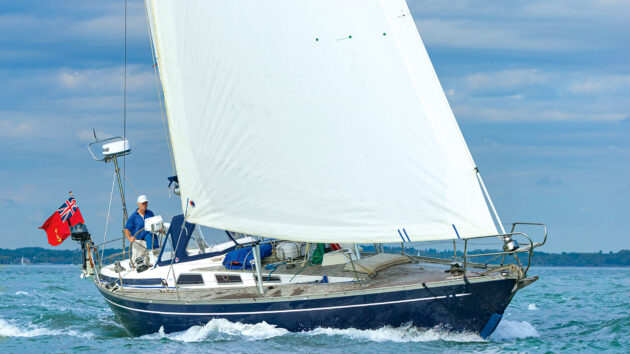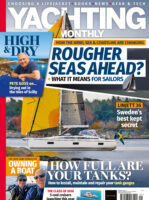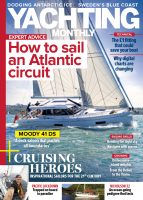We take a look at the famed Swan 38 and ask what other yachts on the market offer similar sailing and accommodation characteristics
The Swan 38 has quite the reputation as being a real sailors’ boat, but there are a number of other 37 and 38ft yachts on the market that offer similar sailing characteristics and levels of accommodation.
Here we picked out three other 37 and 38ft yachts to compare to the Swan.

Swan 38
Some boats’ reputation is such that you might feel almost daunted by the prospect of sailing them, let alone writing about them.
If they’re as good as they’re cracked up to be, you might simply find yourself repeating things that have been said before, over years or even decades. And if they’re not? Do you risk invoking the wrath of diehard enthusiasts who won’t hear a word said against them?
Thankfully, any concerns I might have had on this score didn’t stop me accepting an invitation to sail with Donald Begg on his Swan 38. After all, the Swan 38 is one of those boats that you just have to sail during your lifetime, in the same way that you have to sail the S&S 34 and Contessa 32.
With some of these boats, you can take the approach that most of what has been written about them was written a long time ago, and that what applied then might not be seen as quite so relevant today. Reputations are reputations nonetheless, and the fashions of the day play no part in the way the sea treats the boats that sail on it.
To today’s younger boat show visitors especially, a boat like the Swan 38 might seem irrelevant and outdated. Compared with a typical modern 38-footer, she’s dark and cramped below decks.
She’s not as fast or even as steady downwind in a breeze, and that enormous foretriangle is going to call for some serious winching every time you tack. Then you have that high, up-and-over bridgedeck that means you have to – well, climb up and over it to go down below.
You can understand all this being quite perplexing to a newcomer, who might look at you blankly and ask: ‘What’s so special about the Swan?’
But crucially, the Swan loves to be sailed, and makes you want to carry on. Why? It’s the S&S (Sparkman & Stephens) magic, which her designers certainly worked into the 38.
She possesses qualities that make for a fast, stiff, powerful, smooth and comfortable boat. She has a hull of modest beam with moderate freeboard and a relatively small wetted area, paired with a lead keel that accounts for nearly 40% of her weight, and a good spread of sail.
Her fine forward sections are a soft elliptical shape, giving her a notably easy motion upwind in a seaway. The relatively narrow waterline and deep canoe body are further contributory factors.
Like all Swans of this era, she has a tree trunk for a mast and a tall masthead rig with a large foretriangle.
It’s well-known that the Swan 38 is a wizard to windward, especially when the wind and sea pick up. She carries her canvas, points high and goes fast while boats all around are running out of power, shortening sail, slamming and banging and making life miserable for their crews.
Swan 38 specifications
DESIGNER: Sparkman & Stephens
BUILT: 1973-1979
PRICE: £65,000-£85,000
LOA: 11.60m/38ft 3in
BEAM: 3.50m/11ft 6in
DRAUGHT: 1.90m/6ft 4in
DISPLACEMENT: 8,300kg/18,250 lb
SAIL AREA: 63.45m2/683sq ft

Built in Finland, like the Swan, the Baltic 38 is a pedigree performer. Photo: David Harding
Baltic 38
Boats that can realistically be considered worthy of with the Swan 38 are surprisingly few and far between. While plenty of IOR One Tonners and competitive boats of similar size were built at around the same time, few could compete in terms of build quality, finish or fit-out below decks – and that’s one of the principal reasons for buying a Swan.
Most that can compete in the quality stakes are less performance-orientated – certainly less race-bred – including other Scandinavian designs. X-Yachts of similar size are much newer. The Sigma 38 is an example of a more recent racer/cruiser that’s fast, tough and capable, but without the joinery to drool over.
In many ways, one of the closest equivalents is another Finnish boat designed by an American: Doug Peterson’s Baltic 38.
Dating from the days when Baltic Yachts built boats of this size (they now range from around 65ft upwards), she too has the narrow ends inspired by the IOR, together with a lead keel (as most Finnish boats do), a masthead rig with a large foretriangle and relatively small main, and an up-and-over bridgedeck.
She also shows that Baltic is one of the few yards capable of rivalling Swan when it comes to below-decks finish – not surprisingly, perhaps, given that the yards are near neighbours in Pietarsaari.
Where the Baltic does differ from the Swan is in being roomier down below, thanks to her greater beam and freeboard in a hull that’s the same length to within a few inches. The greater volume is principally a reflection of the fact that she was built almost exactly 10 years later.
Being nearly a foot broader in the beam, she has a roomier saloon and galley, and an aft cabin that’s much more useable in harbour. The Swan has a single berth to port of the cockpit well and a double to starboard with an aperture through the bulkhead to the galley. By contrast, the Baltic has a semi-island double berth beneath the cockpit, with seating either side – less practical at sea, perhaps, but likely to find wider appeal.
Baltic 38 specifications
DESIGNER: Doug Peterson
BUILT: 1982-1989
PRICE: £59,000-£97,000
LOA: 11.60/38ft 1in
BEAM: 3.76m/12ft 4in
DRAUGHT: 2.21m/7ft 3in
DISPLACEMENT: 6,500kg/14,330 lb
SAIL AREA: 67.91m2/731sq ft

A fine performer, with relatively narrow beam and an encapsulated long fin keel. Photo: David Harding
Ohlson 38
If you are drawn to the Swan 38 because you prefer the sailing and seakeeping qualities of performance boats that are relatively deep and narrow rather than beamy and shallow, you might like to have
a look at older alternatives in preference to newer ones.
One that stands out is the Ohlson 38. A fine seaboat, with many race wins and ocean crossings to her credit, she was designed in Sweden in the late 1960s by Einar Ohlson, who made his name with a series of multi-Olympic-medal-winning 5.5 Metres.
The Ohlson 38 was moulded by Tylers in Kent and fitted out by a number of yards in the UK and Europe including Bröderna Ölsonner, which later became Malö Yachts.
Some German and Swedish-built boats had wooden decks, but most were GRP, including the best-known Ohlson 38 of all, Robertson’s Golly, sailed by Clare Frances in the 1975 OSTAR (Observer Singlehanded TransAtlantic Race).
Robertson’s Golly was sponsored by the well-known jam manufacturers and, coincidentally, fitted out by Alexander Robertson of Argyll, a prominent Scottish boatbuilder that also built the Piper (now the Rustler 24) and the Etchells 22.
As befits her age and pedigree, the Ohlson has a more traditional feel than more recent designs. She’s only just over 10ft (3.06m) in the beam, with an encapsulated long fin keel that runs into a skeg supporting the rudder (though later boats built entirely by Tylers as the Tuffglass 38 had bolt-on keels).
A number of Ohlson 38s were rigged as yawls, and nearly 130 were built in total.
Ohlson 38 specifications
DESIGNER: Einar Ohlson
BUILT: 1968-1980
PRICE: £25,000-£40,000
LOA: 11.30/37ft 1in
BEAM: 3.06m/10ft 0in
DRAUGHT: 1.71m/5ft 7in
DISPLACEMENT: 6,759kg/14,900 lb
SAIL AREA: 45.00m2/484sq ft

Oyster 37s are well-behaved boats and still competitive on the race course. Photo: David Harding
Oyster 37
In terms of reputation, Britain’s equivalent to Swan – if there is one – is undoubtedly Oyster. The Oyster name has long been associated with high-quality boatbuilding, while many of the earlier models in particular were derived from racing yachts.
The boat that started it all for Oyster’s founder, Richard Matthews, was the UFO 34, designed by Holman & Pye and based on a successful three-quarter tonner. Holman & Pye went on to design a good number of the early Oysters, including the 37, before Stephen Jones added several more, most of them also designed to race under the IOR.
Despite the IOR influences, builders such as Swan, Baltic and Oyster avoided extremes, working with designers who created fast and competitive boats that were also well-behaved and able to look after themselves and their crew when the going got tough. Holman and Pye drew capable, good-looking boats, and the Oyster 37 is no exception.
First launched five years after the Swan, she has the characteristic narrow ends and fine bow sections of the era, together with a masthead rig, large foretriangle and a keel (in lead) that’s longer in the chord at the root than at the tip.
Below decks, the Oyster’s race breeding shows in the pilot berths in the saloon. Abaft the chart table to starboard is an aft cabin – only extending to the centreline – with up to three further berths including a pipe cot.
The Oyster 37 should not be confused with Holman & Pye’s later and much more cruisy Oyster Heritage 37.
Oyster 37 specifications
DESIGNER: Holman & Pye
BUILT: 1978-1980
PRICE: £25,000-£40,000
LOA: 11.28/37ft 0in
BEAM: 3.68m/12ft 1in
DRAUGHT: 1.91m/6ft 3in
DISPLACEMENT: 7,498kg/16.530 lb
SAIL AREA: 59.92m2/645sq ft
Enjoyed reading this?
A subscription to Yachting Monthly magazine costs around 40% less than the cover price, so you can save money compared to buying single issues.
Print and digital editions are available through Magazines Direct – where you can also find the latest deals.
YM is packed with information to help you get the most from your time on the water.
-
-
- Take your seamanship to the next level with tips, advice and skills from our experts
- Impartial in-depth reviews of the latest yachts and equipment
- Cruising guides to help you reach those dream destinations
-
Follow us on Facebook, Twitter and Instagram.
Note: We may earn a commission when you buy through links on our site, at no extra cost to you. This doesn’t affect our editorial independence.





